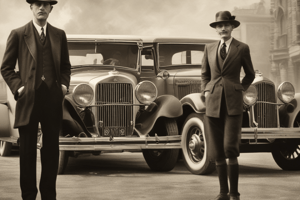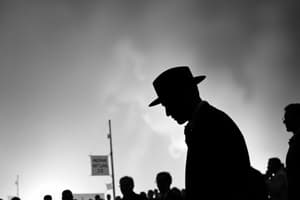Podcast
Questions and Answers
What was a significant cultural movement that took place during the Roaring Twenties?
What was a significant cultural movement that took place during the Roaring Twenties?
- The Great Migration
- Harlem Renaissance (correct)
- The Lost Generation
- Women's Suffrage Movement
What was the event that drew the United States into World War II?
What was the event that drew the United States into World War II?
- The invasion of Poland
- The Japanese attack on Pearl Harbor (correct)
- The sinking of the USS Arizona
- The Battle of Britain
What was the name of the plan that provided economic aid to European countries after World War II?
What was the name of the plan that provided economic aid to European countries after World War II?
- The Berlin Airlift
- The Truman Doctrine
- The Marshall Plan (correct)
- The Lend-Lease Act
Who was the leader of the Civil Rights Movement who delivered the famous 'I Have a Dream' speech?
Who was the leader of the Civil Rights Movement who delivered the famous 'I Have a Dream' speech?
What was the period of economic downturn that occurred in the United States in the 1930s?
What was the period of economic downturn that occurred in the United States in the 1930s?
What was the term used to describe the fear of communism and the persecution of suspected communists in the United States during the Cold War Era?
What was the term used to describe the fear of communism and the persecution of suspected communists in the United States during the Cold War Era?
Flashcards are hidden until you start studying
Study Notes
Roaring Twenties (1920s)
- Post-WWI economic boom, cultural and social changes
- Characteristics:
- Mass production and consumerism
- Urbanization and migration
- Rise of jazz and Harlem Renaissance
- Flappers, speakeasies, and relaxed social norms
- New technologies (e.g., radio, automobiles)
- Notable figures:
- President Calvin Coolidge
- Al Capone (organized crime)
- Louis Armstrong and Duke Ellington (jazz musicians)
- F. Scott Fitzgerald and Ernest Hemingway (authors)
World War II (1941-1945)
- US involvement in global conflict
- Causes:
- Japanese attack on Pearl Harbor (1941)
- Axis powers (Germany, Italy, Japan) expansion
- Major events:
- D-Day invasion (Normandy, 1944)
- Atomic bombings of Hiroshima and Nagasaki (1945)
- Allied victory and defeat of Axis powers
- Home front:
- Rationing and mobilization
- Women's roles in war efforts (e.g., Rosie the Riveter)
- Internment of Japanese Americans
Cold War Era (1945-1991)
- Post-WWII rivalry between US and Soviet Union
- Key events:
- Truman Doctrine (1947) and Marshall Plan (1948)
- Berlin Blockade and Airlift (1948-1949)
- Korean War (1950-1953)
- Cuban Missile Crisis (1962)
- Domestic politics:
- Red Scare and McCarthyism (1950s)
- Civil Rights Movement (1950s-1960s)
- Notable figures:
- President Harry Truman
- Senator Joseph McCarthy
- Soviet leaders (e.g., Stalin, Khrushchev)
Civil Rights Movement (1950s-1960s)
- Struggle for racial equality and social justice
- Key events:
- Montgomery Bus Boycott (1955-1956)
- Little Rock Nine (1957)
- March on Washington (1963)
- Civil Rights Act (1964) and Voting Rights Act (1965)
- Notable figures:
- Martin Luther King Jr.
- Rosa Parks
- Malcolm X
- Presidents Eisenhower, Kennedy, and Johnson
Great Depression (1929-1941)
- Global economic downturn, severe in US
- Causes:
- Stock market crash (1929)
- Overproduction and underconsumption
- Bank failures and credit crisis
- Effects:
- High unemployment (25%) and poverty
- Homelessness and shantytowns (Hoovervilles)
- Decreased international trade
- Government responses:
- President Herbert Hoover's limited interventions
- President Franklin D. Roosevelt's New Deal programs (e.g., Works Progress Administration, Civilian Conservation Corps)
Roaring Twenties (1920s)
- Post-WWI economic boom, cultural and social changes characterized the decade
- Mass production and consumerism led to increased urbanization and migration
- Jazz and Harlem Renaissance flourished, with notable figures like Louis Armstrong and Duke Ellington
- Flappers, speakeasies, and relaxed social norms defined the era's cultural landscape
- New technologies like radio and automobiles emerged
World War II (1941-1945)
- Japanese attack on Pearl Harbor in 1941 drew the US into the global conflict
- Axis powers' expansion led to the US involvement in the war
- D-Day invasion in Normandy in 1944 marked a major turning point
- Atomic bombings of Hiroshima and Nagasaki in 1945 contributed to the Allied victory
- Women's roles in war efforts, like Rosie the Riveter, became prominent
- Internment of Japanese Americans occurred on the home front
Cold War Era (1945-1991)
- Post-WWII rivalry between the US and Soviet Union characterized the era
- Truman Doctrine in 1947 and Marshall Plan in 1948 marked key events
- Berlin Blockade and Airlift in 1948-1949 showed Soviet aggression
- Korean War from 1950-1953 was a major conflict
- Cuban Missile Crisis in 1962 brought the world to the brink of nuclear war
- Red Scare and McCarthyism in the 1950s led to domestic political tension
- Civil Rights Movement gained momentum during this era
Civil Rights Movement (1950s-1960s)
- Struggle for racial equality and social justice defined the movement
- Montgomery Bus Boycott from 1955-1956 was a key event
- Little Rock Nine in 1957 and March on Washington in 1963 were significant milestones
- Civil Rights Act in 1964 and Voting Rights Act in 1965 were landmark legislation
- Martin Luther King Jr., Rosa Parks, and Malcolm X were prominent figures
- Presidents Eisenhower, Kennedy, and Johnson played important roles
Great Depression (1929-1941)
- Global economic downturn severely affected the US
- Stock market crash in 1929 triggered the depression
- Overproduction and underconsumption, as well as bank failures and credit crisis, were contributing factors
- High unemployment (25%) and poverty rates characterized the era
- Homelessness and shantytowns (Hoovervilles) became widespread
- Decreased international trade further exacerbated the economic downturn
- President Herbert Hoover's limited interventions were insufficient
- President Franklin D. Roosevelt's New Deal programs, such as the Works Progress Administration and Civilian Conservation Corps, helped alleviate the crisis
Studying That Suits You
Use AI to generate personalized quizzes and flashcards to suit your learning preferences.




